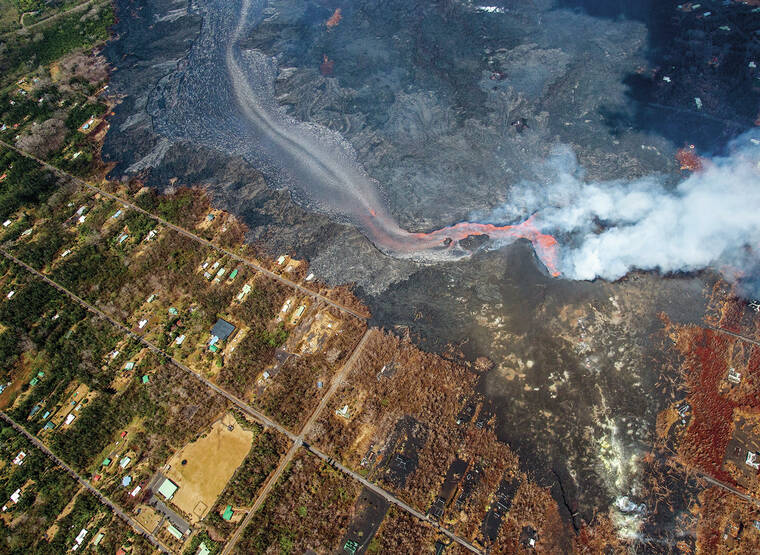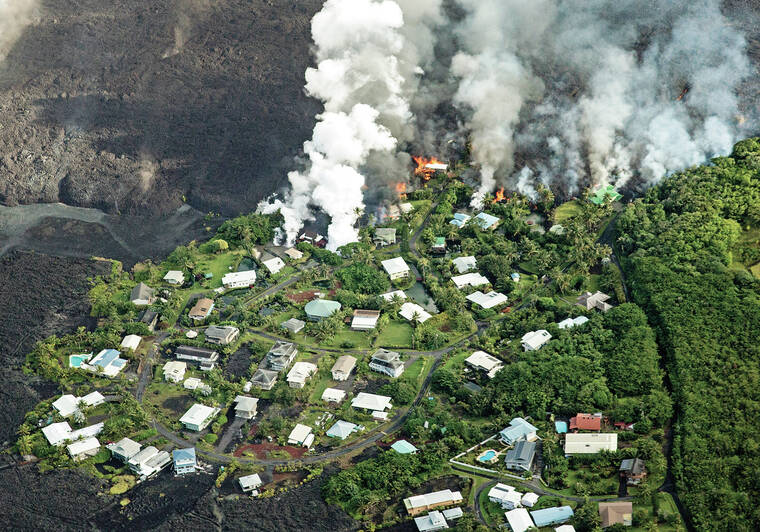More than 800 victims of the 2018 Kilauea eruption are hoping Hawaii County will buy their properties after the final application phase for the Voluntary Housing Buyout Program ended last month.
The program — which allows owners of properties damaged, isolated or destroyed by the eruption to sell their lots to the county for up $230,000 — began in 2021 and had three application phases. When the final application phase ended on Oct. 31, the county had a total of 820 active applications.
“The numbers are a bit higher than we expected,” said Recovery Officer Douglas Le. He said that a February 2021 survey indicated that about 600 people were interested in participating the program. “So, the total number is a bit higher than that survey, but still not as high as it could have been.”
Of the 820 applications, 311 are from owners of primary residences impacted by the eruption. Only primary homeowners were allowed to apply during the program’s first phase, which ran from May 2021 through July 2021, and are therefore the only applicants who have actually received buyouts so far.
Le said that as of last week, the county has closed deals with 75 of the 311 primary residence applicants, with an average buyout price of $180,000.
He said that the county recovery team is aiming for a consistent rate of closing 10 deals per week, which should clear the bulk of the primary residential applications by the early summer of 2023. After that, he said the team should be able to transition smoothly to processing applications from owners of secondary homes, who were allowed to apply during the program’s second phase, from November 2021 through January 2022.
Based on the current rate, Le estimated it will take until 2024 before every application is closed. The most recent phase, which ran from July through October, allowed owners of undeveloped property to apply, but for a reduced maximum payout of up to $22,000.
Le said that between primary and secondary residential applicants, the county has committed about $92.8 million of the program’s $107.5 million budget, which is funded through the U.S. Department of Housing and Urban Development’s Community Development Block Grant-Disaster Recovery program.
“Primary and secondary homeowners have asked if they’re going to lose their place in line now that so many people have applied,” Le said. “The answer is no — the people have their place in line, and that won’t change.”
However, Le said that, with 300 applications from undeveloped property owners, “we have a feeling that we won’t have enough to serve everyone.” He added that because it will be a long time before all the deals are closed on primary and secondary home applicants, it’s not clear exactly how much money will be left over for the undeveloped properties.
Now that all the application phases are closed, Le said the county can start to assess the condition of all the properties it can acquire and to develop a plan for how the land will be used.
Because of HUD requirements for how the project funds are used, all of the properties acquired through the buyout program must be maintained as open spaces. What that actually means, however, requires a bit of interpretation.
Le said the buyout program is modeled after similar buyout programs conducted in flood-prone regions on the mainland, which also had open space requirements in order to minimize the risk of damage from future floods.
“Of course, this is the first buyout program for an eruption,” Le said.
The open space requirements preclude residences, but not necessarily agricultural uses, Le said.
Any ag-related equipment or infrastructure on the open space land should be easily movable in order to minimize the county’s risk exposure from future eruptions, he said. Because of that, any agricultural uses should probably be limited to crops with faster turnaround times that require less hard infrastructure to grow.
Le also said the county could partner with other entities or nonprofits that would act as stewards of the buyout properties.
All of these possibilities are dependent on what the nearby communities prefer for the land, Le said.
The county will hold meetings to discuss the public’s preferences, but he added that it is still too early to say when those meetings might happen.
“That’s a next-year conversation,” Le said.
Email Michael Brestovansky at mbrestovansky@hawaiitribune-herald.com.









